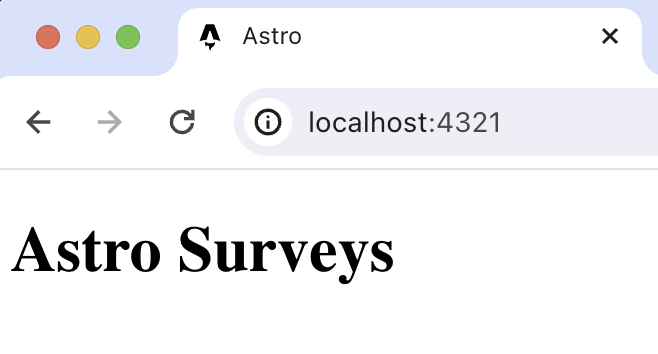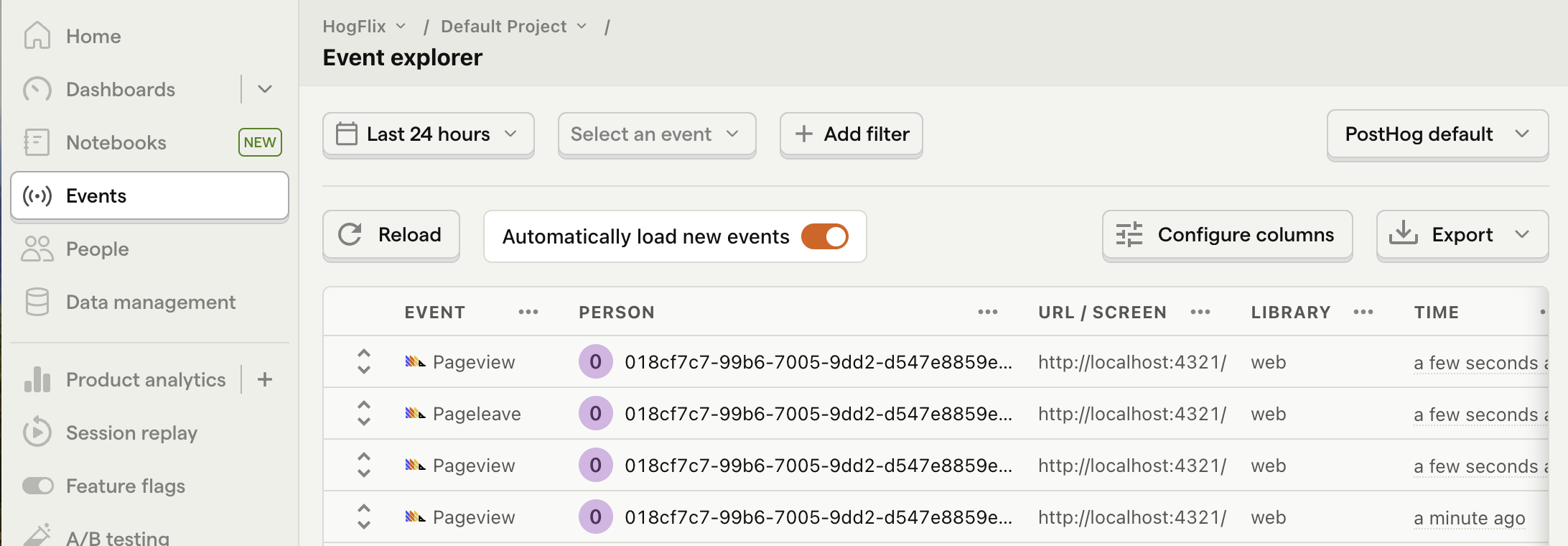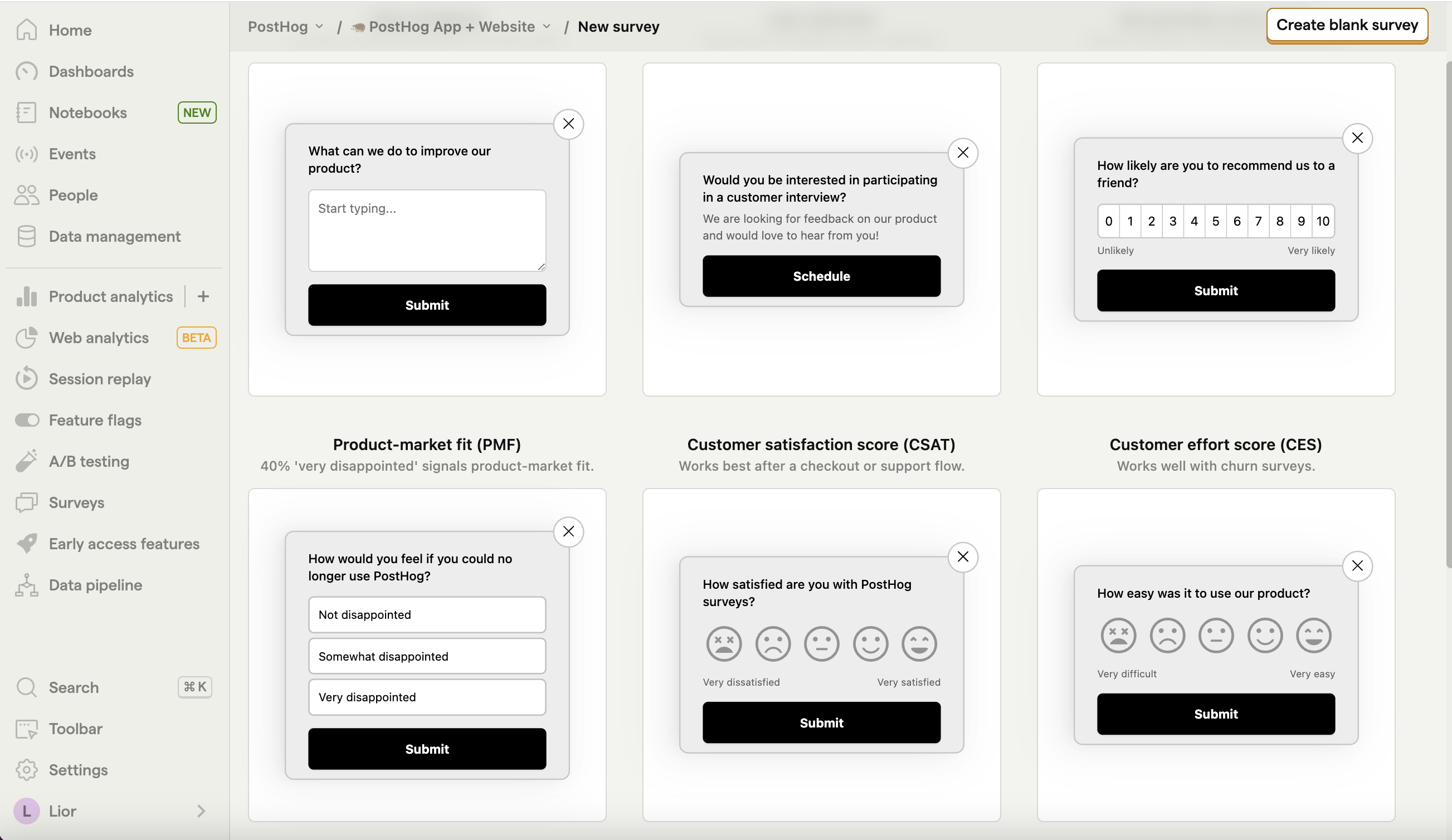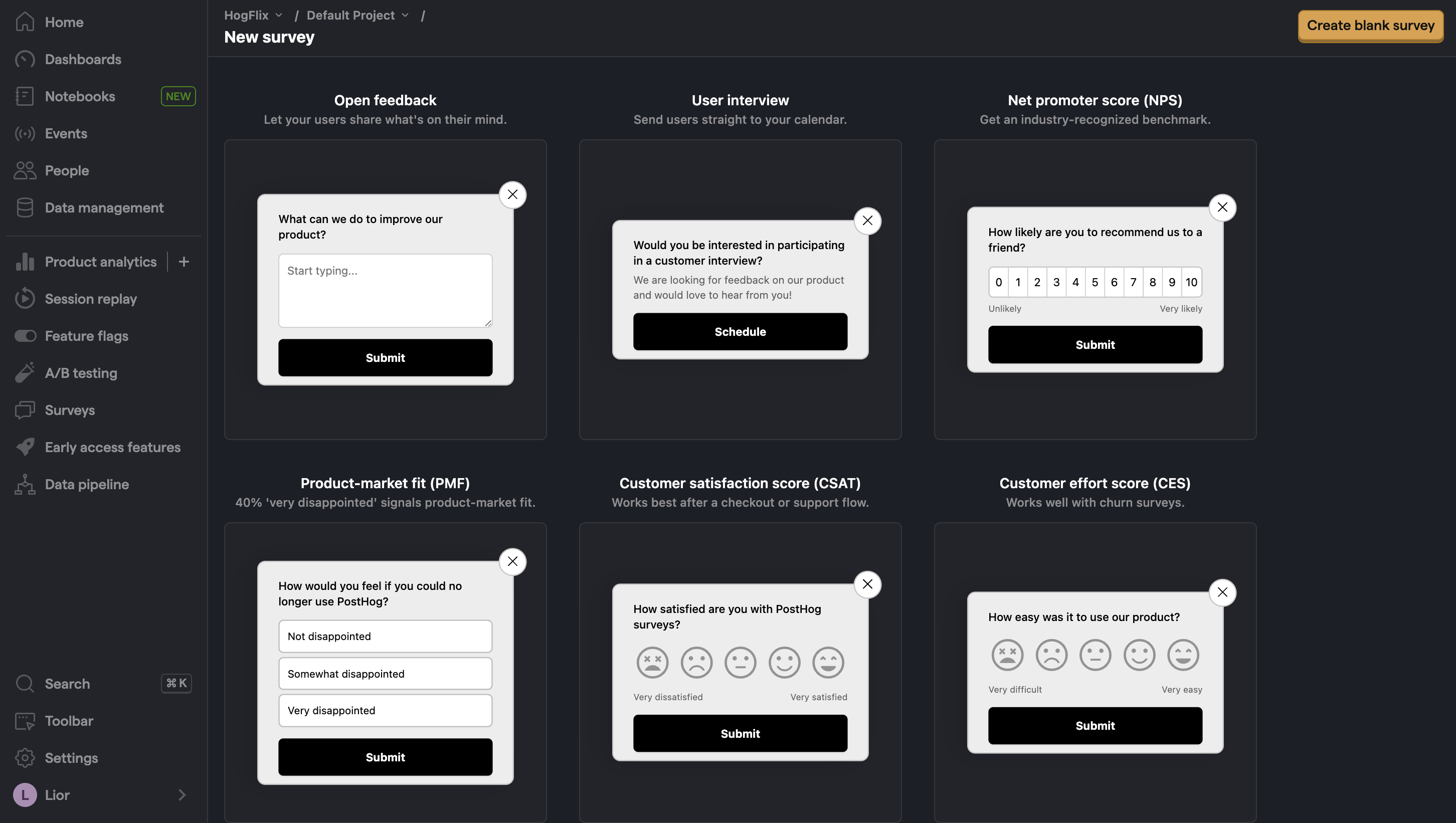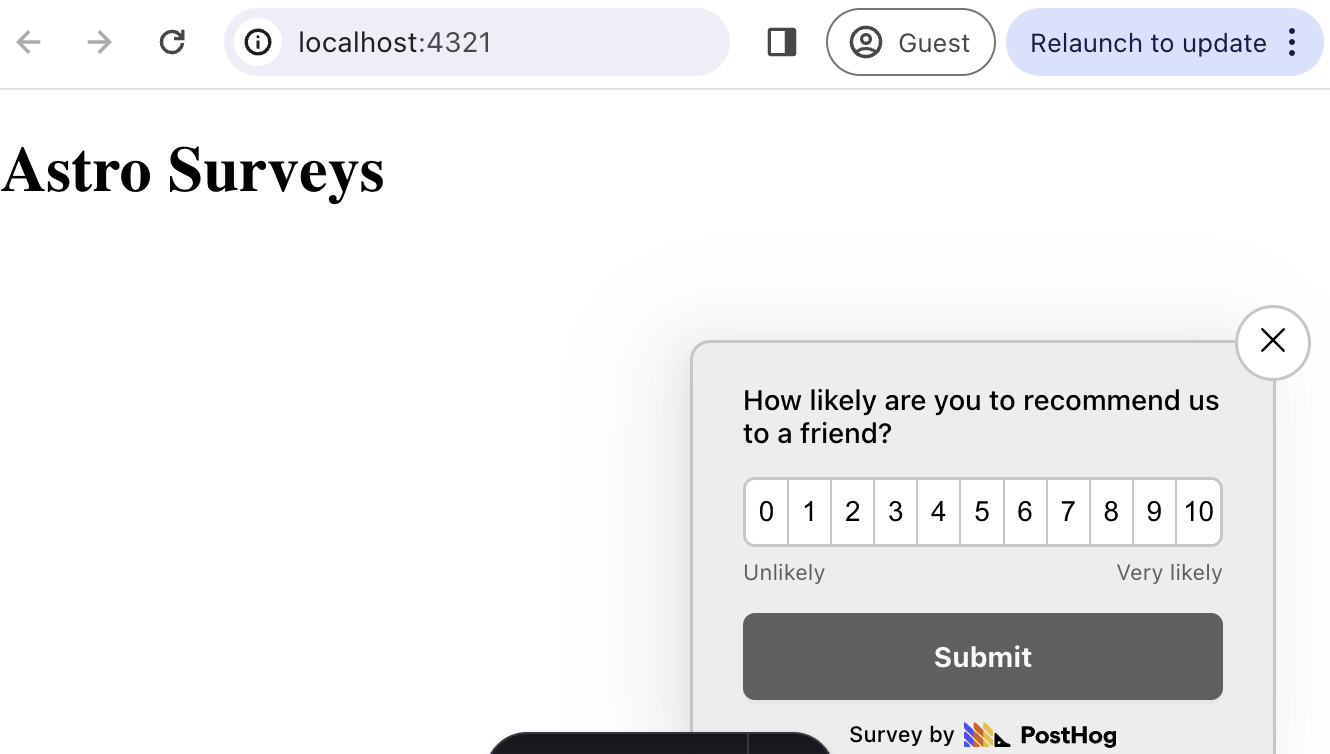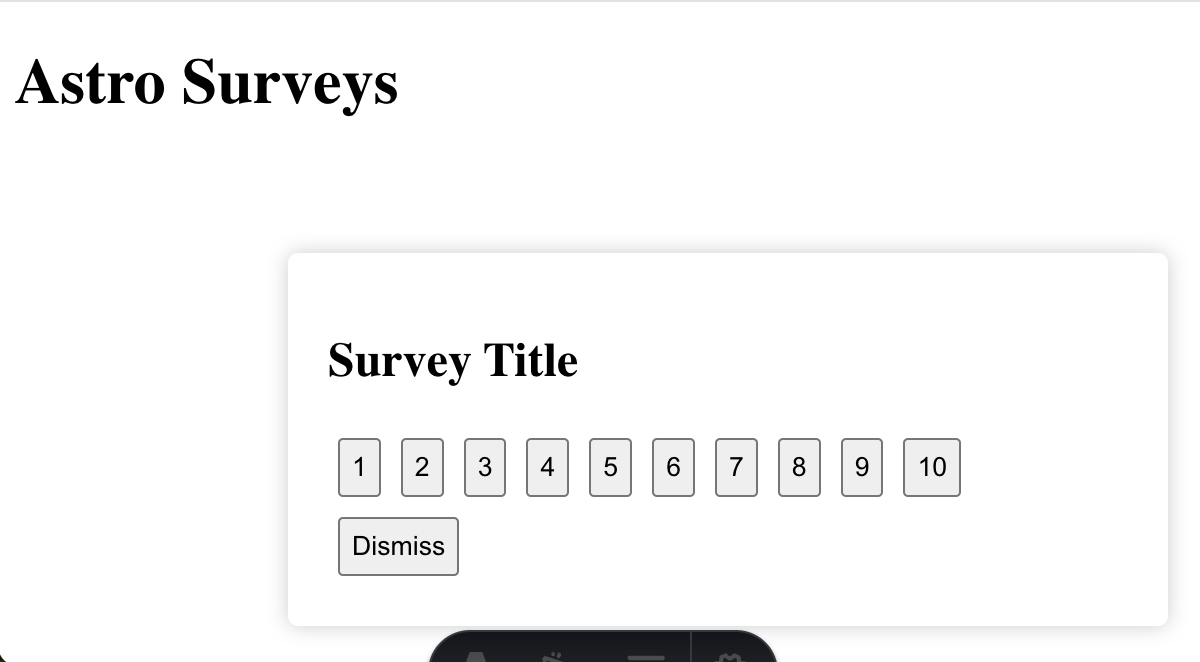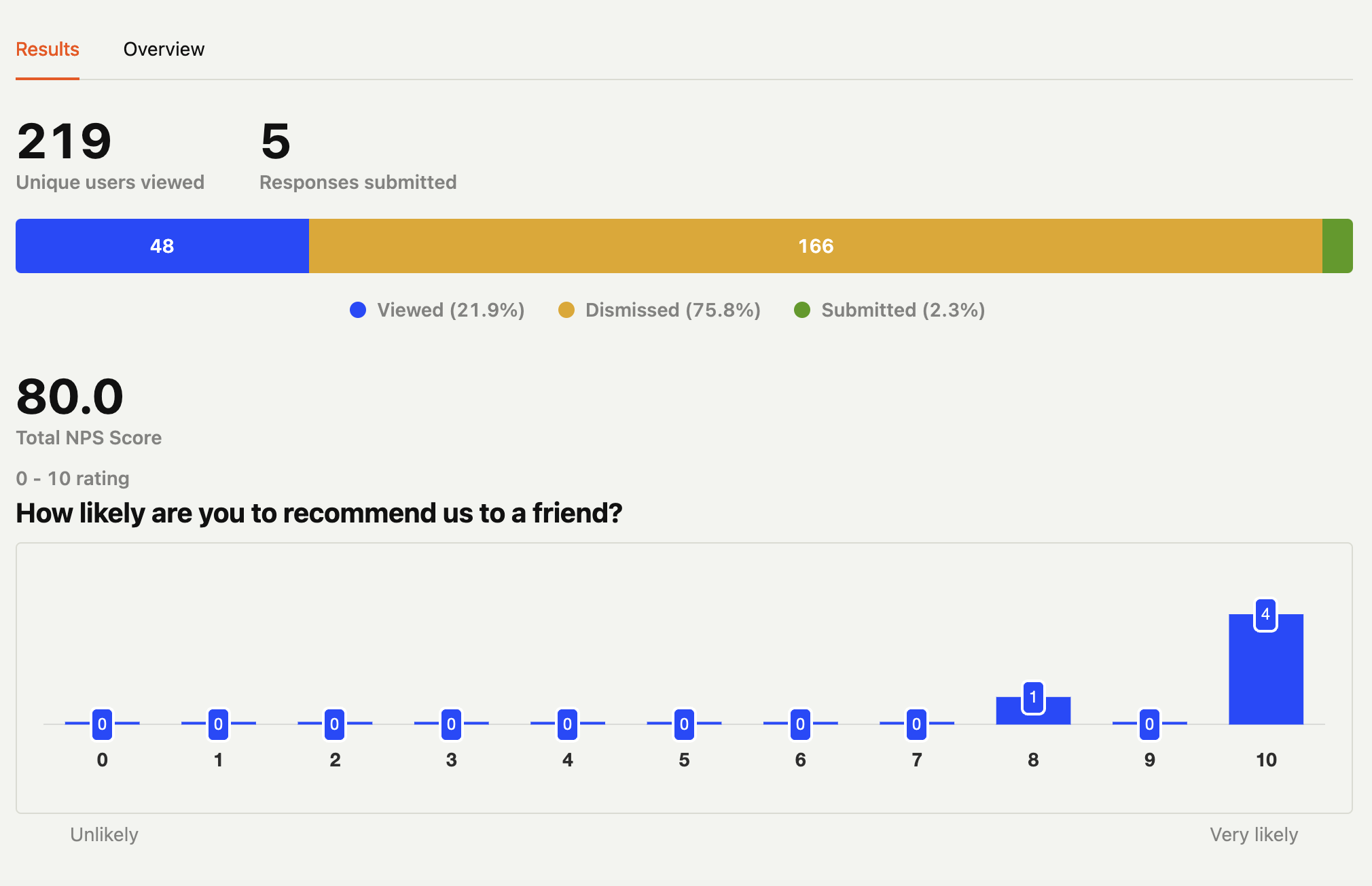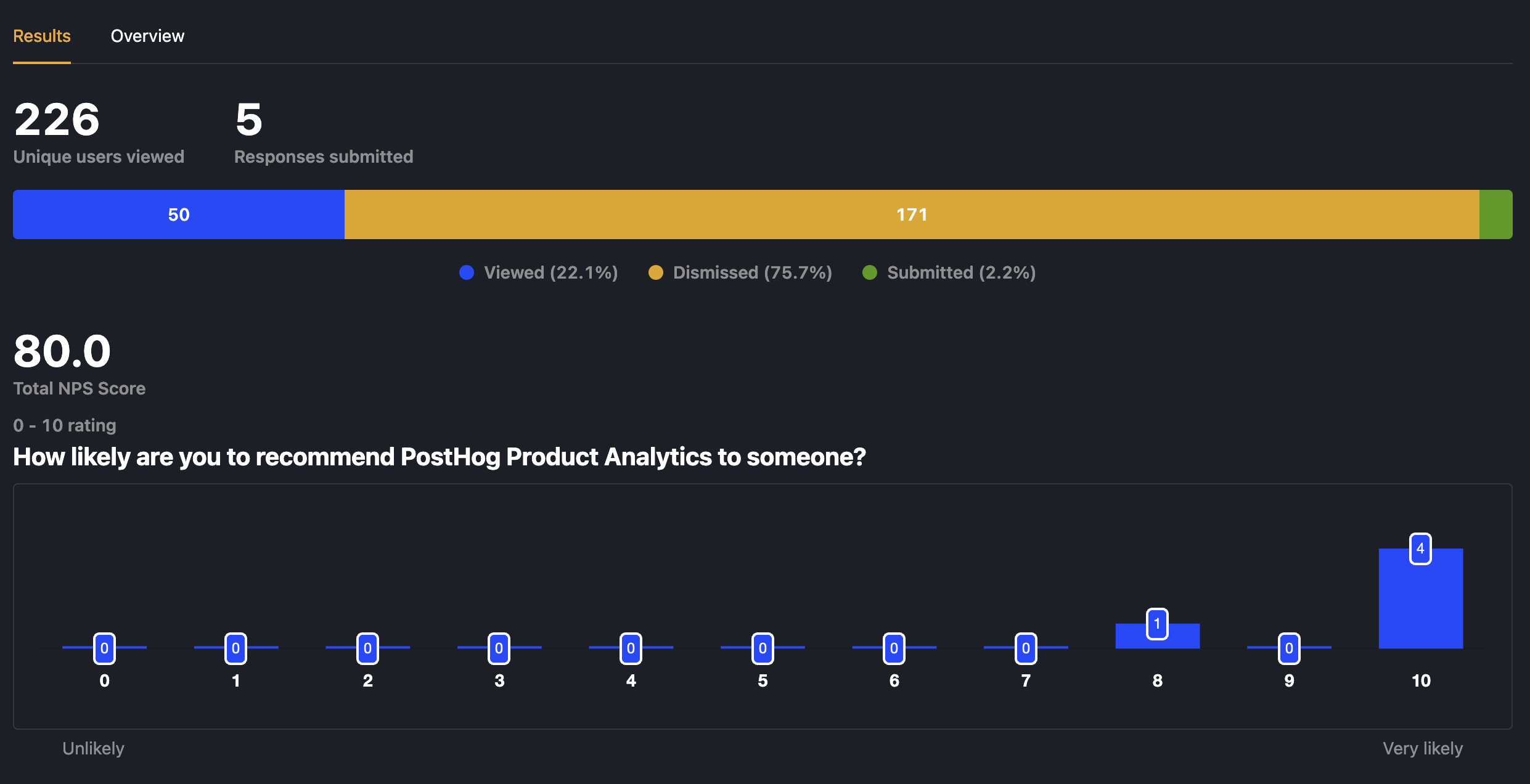Surveys
We'll create a basic Astro app, add PostHog, create a survey, and then show you how to display the survey in the app and get responses.
First, ensure Node.js is installed
When prompted in the command line, name your new project directory (we chose astro-survey), start your new project Empty, choose No for TypeScript, Yes for install dependencies, and No for git repository.
Next, replace the code in src/pages/index.astro with a simple heading:
-- -
-- -
< html lang = "en" >
< head >
< meta charset = "utf-8" / >
< link rel = "icon" type = "image/svg+xml" href = "/favicon.svg" / >
< meta name = "viewport" content = "width=device-width" / >
< meta name = "generator" content = { Astro . generator } / >
< title > Astro < / title >
< / head >
< body >
< h1 > Astro Surveys < / h1 >
< / body >
< / html >
Run npm run dev and navigate to http://localhost:4321 to see your app in action.
We use PostHog to create and control our survey as well as monitor results. If you don't have a PostHog instance, you can sign up for free here
To start, create a new components folder in the src folder. In this folder, create a posthog.astro file
cd ./src
mkdir components
cd ./components
touch posthog.astro
In this file, add your PostHog Web snippet. You can find this in your project settings
-- -
-- -
< script >
! function ( t , e ) { var o , n , p , r ; e . __SV || ( window . posthog = e , e . _i = [ ] , e . init = function ( i , s , a ) { function g ( t , e ) { var o = e . split ( "." ) ; 2 == o . length && ( t = t [ o [ 0 ] ] , e = o [ 1 ] ) , t [ e ] = function ( ) { t . push ( [ e ] . concat ( Array . prototype . slice . call ( arguments , 0 ) ) ) } } ( p = t . createElement ( "script" ) ) . type = "text/javascript" , p . crossOrigin = "anonymous" , p . async = ! 0 , p . src = s . api_host + "/static/array.js" , ( r = t . getElementsByTagName ( "script" ) [ 0 ] ) . parentNode . insertBefore ( p , r ) ; var u = e ; for ( void 0 !== a ? u = e [ a ] = [ ] : a = "posthog" , u . people = u . people || [ ] , u . toString = function ( t ) { var e = "posthog" ; return "posthog" !== a && ( e += "." + a ) , t || ( e += " (stub)" ) , e } , u . people . toString = function ( ) { return u . toString ( 1 ) + ".people (stub)" } , o = "capture identify alias people.set people.set_once set_config register register_once unregister opt_out_capturing has_opted_out_capturing opt_in_capturing reset isFeatureEnabled onFeatureFlags getFeatureFlag getFeatureFlagPayload reloadFeatureFlags group updateEarlyAccessFeatureEnrollment getEarlyAccessFeatures getActiveMatchingSurveys getSurveys getNextSurveyStep onSessionId" . split ( " " ) , n = 0 ; n < o . length ; n ++ ) g ( u , o [ n ] ) ; e . _i . push ( [ i , s , a ] ) } , e . __SV = 1 ) } ( document , window . posthog || [ ] ) ;
posthog . init ( '<ph_project_api_key>' , {
api_host : 'https://us.i.posthog.com' ,
defaults : '2025-11-30' ,
} )
< / script >
The next step is to a create a Layout posthog.astro. Create a new folder layouts in src and then a new file Layout.astro:
cd .. / .. /src
mkdir layouts
cd ./layouts
touch Layout.astro
Add the following code to Layout.astro:
-- -
import PostHog from '../components/posthog.astro'
-- -
< head >
< PostHog / >
< / head >
Lastly, update index.astro to use the new Layout:
-- -
import Layout from '../layouts/Layout.astro' ;
-- -
< Layout >
< html lang = "en" >
< head >
< meta charset = "utf-8" / >
< link rel = "icon" type = "image/svg+xml" href = "/favicon.svg" / >
< meta name = "viewport" content = "width=device-width" / >
< meta name = "generator" content = { Astro . generator } / >
< title > Astro < / title >
< / head >
< body >
< h1 > Astro Surveys < / h1 >
< / body >
< / html >
< / Layout >
Once you’ve done this, reload your app and you should see events appearing in the PostHog events explorer
There are two options for displaying a survey using PostHog:
Use PostHog's prebuilt survey UI. Implement your own survey UI. This tutorial will cover how to implement both options:
This is the simplest option. PostHog has a variety of survey templates survey docs
To create a survey with a prebuilt UI, go to the surveys tab
Select any template, or you can create your own by clicking "Create blank survey". Then, configure your survey with the following details:
Ensure Presentation is set to Popover . Set the display conditions to All users. Use the default values for everything else. Then, click "Save as draft" and then "Launch". Your survey is now live and you should see it in your app. After submitting responses, you can view results in PostHog
If you prefer to have complete control of your survey UI and logic, you can still use PostHog to keep track of and analyze your results.
First, create a survey in PostHog like in option 1 above (for this tutorial, we use a Net Promoter Score survey template). The only difference is you must set Presentation to API .
Then, there are four parts to adding code for our custom survey:
Create the survey UI. Fetch the survey from PostHog. Add the logic for displaying and hiding it. Capture interactions from it. To show you how to do this, we've created a sample survey UI for this tutorial. Although it's written in pure HTML + JavaScript, the same concepts apply if you're using any UI frameworks in your Astro project – such as React Vue
First create a new file in your components directory called CustomSurvey.astro:
cd .. /components
touch CustomSurvey.astro
Paste the following code into CustomSurvey.astro
src/components/CustomSurvey.astro -- -
-- -
< div class = "survey" >
< h2 id = "survey-title" > Survey Title < / h2 >
< div >
{ Array . from ( { length : 10 } , ( _ , i ) => i + 1 ) . map ( i => (
< button key = { i } class = "button" id = { ` button- ${ i } ` } > { i } < / button >
) ) }
< / div >
< div >
< button class = "button" id = "dismiss-button" > Dismiss < / button >
< / div >
< / div >
< script >
function emitDismiss ( ) {
const event = new CustomEvent ( 'dismiss_survey' ) ;
window . dispatchEvent ( event ) ;
}
function emitSubmit ( value ) {
const event = new CustomEvent ( 'submit_survey' , { detail : value } ) ;
window . dispatchEvent ( event ) ;
}
document . getElementById ( 'dismiss-button' ) . addEventListener ( 'click' , emitDismiss ) ;
for ( let i = 1 ; i <= 10 ; i ++ ) {
document . getElementById ( ` button- ${ i } ` ) . addEventListener ( 'click' , function ( ) {
emitSubmit ( i ) ;
} ) ;
}
< / script >
< style >
. survey {
position : fixed ;
bottom : 20px ;
right : 20px ;
width : 400px ;
padding : 20px ;
background - color : #ffffff ;
box - shadow : 0px 0px 10px rgba ( 0 , 0 , 0 , 0.2 ) ;
border - radius : 5px ;
z - index : 1000 ;
}
. button {
margin : 5px ;
padding : 5px ;
}
< / style >
Then, in src/pages/index.astro, import your new component and add the button event handlers in a <script> in the body:
-- -
import Layout from '../layouts/Layout.astro' ;
import CustomSurvey from '../components/CustomSurvey.astro' ;
-- -
< Layout >
< html lang = "en" >
< head >
< meta charset = "utf-8" / >
< link rel = "icon" type = "image/svg+xml" href = "/favicon.svg" / >
< meta name = "viewport" content = "width=device-width" / >
< meta name = "generator" content = { Astro . generator } / >
< title > Astro < / title >
< / head >
< body >
< h1 > Astro Surveys < / h1 >
< CustomSurvey class = "survey" / >
< script >
function toggleSurveyDisplay ( show ) {
const surveyElement = document . querySelector ( '.survey' ) ;
if ( surveyElement ) {
surveyElement . style . display = show ? 'block' : 'none' ;
}
}
function handleDismiss ( ) {
toggleSurveyDisplay ( false ) ;
}
function handleSubmit ( event ) {
toggleSurveyDisplay ( false ) ;
}
if ( typeof window !== 'undefined' ) {
window . addEventListener ( 'dismiss_survey' , handleDismiss ) ;
window . addEventListener ( 'submit_survey' , handleSubmit ) ;
}
< / script >
< / body >
< / html >
< / Layout >
This shows a survey popup every time you visit your app's homepage.
PostHog keeps track of all active surveys for a user. This is especially helpful if you set up custom display conditions
To fetch the active surveys, we use posthog.getActiveMatchingSurveys(). This returns an array of survey objects that looks like this:
[
{
"id" : "018cfcd5-107e-0000-49a1-8e7c6b825947" ,
"name" : "Net promoter score (NPS) API Survey" ,
"description" : "" ,
"type" : "api" ,
"linked_flag_key" : null ,
"targeting_flag_key" : null ,
"questions" : [
{
"type" : "rating" ,
"scale" : 10 ,
"display" : "number" ,
"question" : "How likely are you to recommend us to a friend?" ,
"description" : "" ,
"lowerBoundLabel" : "Unlikely" ,
"upperBoundLabel" : "Very likely"
}
] ,
"conditions" : null ,
"start_date" : "2024-01-12T08:41:20.614000Z" ,
"end_date" : null
}
]
To fetch this array and integrate it with your survey UI, update your <script> in index.astro:
-- -
import Layout from '../layouts/Layout.astro' ;
import CustomSurvey from '../components/CustomSurvey.astro' ;
-- -
< Layout >
< html lang = "en" >
< head >
// your existing code
< / head >
< body >
// your existing code
< script >
let surveyID = '' ;
document . addEventListener ( 'DOMContentLoaded' , async ( ) => {
window . posthog . getActiveMatchingSurveys ( ( surveys ) => {
if ( surveys . length > 0 ) {
const survey = surveys [ 0 ] ;
document . getElementById ( 'survey-title' ) . textContent = survey . questions [ 0 ] . question ;
surveyID = survey . id ;
}
} ) ;
} ) ;
// your existing code
< / script >
< / body >
< / html >
< / Layout >
We want to make sure we don't show the survey again to users who have either submitted or dismissed it. We use localStorage
-- -
import Layout from '../layouts/Layout.astro' ;
import CustomSurvey from '../components/CustomSurvey.astro' ;
-- -
< Layout >
< html lang = "en" >
< head >
// your existing code
< / head >
< body >
// your existing code
< script >
let surveyID = '' ;
document . addEventListener ( 'DOMContentLoaded' , async ( ) => {
window . posthog . getActiveMatchingSurveys ( ( surveys ) => {
if ( surveys . length > 0 ) {
const survey = surveys [ 0 ] ;
document . getElementById ( 'survey-title' ) . textContent = survey . questions [ 0 ] . question ;
surveyID = survey . id ;
// Check if user has already interacted with the survey
const hasInteractedWithSurvey = localStorage . getItem ( ` hasInteractedWithSurvey_ ${ surveyID } ` ) ;
toggleSurveyDisplay ( ! hasInteractedWithSurvey ) ;
}
} ) ;
} ) ;
function toggleSurveyDisplay ( show ) {
// your existing code
}
function handleDismiss ( ) {
toggleSurveyDisplay ( false ) ;
localStorage . setItem ( ` hasInteractedWithSurvey_ ${ surveyID } ` , 'true' ) ;
}
function handleSubmit ( event ) {
toggleSurveyDisplay ( false ) ;
localStorage . setItem ( ` hasInteractedWithSurvey_ ${ surveyID } ` , 'true' ) ;
}
// your existing code
< / script >
< / body >
< / html >
< / Layout >
Lastly, update the CSS in CustomSurvey.astro so that the survey is hidden by default:
-- -
-- -
// Your existing code
< style >
. survey {
display : none ; /* add this line */
/* rest of your CSS */
}
/* rest of your CSS */
< style >
The final step in setting up our survey is capturing interactions. This enables us to analyze the results in PostHog.
There are 3 events to capture:
"survey shown""survey dismissed""survey sent" (for responses)You can capture these events using posthog.capture():
-- -
import Layout from '../layouts/Layout.astro' ;
import CustomSurvey from '../components/CustomSurvey.astro' ;
-- -
< Layout >
< html lang = "en" >
< head >
// your existing code
< / head >
< body >
// your existing code
< script >
// your existing code
function toggleSurveyDisplay ( show ) {
const surveyElement = document . querySelector ( '.survey' ) ;
if ( surveyElement ) {
surveyElement . style . display = show ? 'block' : 'none' ;
if ( show ) {
window . posthog . capture ( "survey shown" , {
$survey_id : surveyID // required
} )
}
}
}
function handleDismiss ( ) {
toggleSurveyDisplay ( false ) ;
localStorage . setItem ( ` hasInteractedWithSurvey_ ${ surveyID } ` , 'true' ) ;
window . posthog . capture ( "survey dismissed" , {
$survey_id : surveyID // required
} )
}
function handleSubmit ( event ) {
toggleSurveyDisplay ( false ) ;
localStorage . setItem ( ` hasInteractedWithSurvey_ ${ surveyID } ` , 'true' ) ;
window . posthog . capture ( "survey sent" , {
$survey_id : surveyID , // required
$survey_response_a3071551 - d599 - 4eeb - 9ffe - 69e93dc647b6 : event . detail , // required. Convert numbers to string
$survey_questions : [
{
id : "a3071551-d599-4eeb-9ffe-69e93dc647b6" ,
question : "How likely are you to recommend us to a friend?" ,
}
] // required for `getSurveyResponse` to work as expected
} )
}
// your existing code
< / script >
< / body >
< / html >
< / Layout >
Altogether, your index.astro should look like this:
-- -
import Layout from '../layouts/Layout.astro' ;
import CustomSurvey from '../components/CustomSurvey.astro' ;
-- -
< Layout >
< html lang = "en" >
< head >
< meta charset = "utf-8" / >
< link rel = "icon" type = "image/svg+xml" href = "/favicon.svg" / >
< meta name = "viewport" content = "width=device-width" / >
< meta name = "generator" content = { Astro . generator } / >
< title > Astro < / title >
< / head >
< body >
< h1 > Astro Surveys < / h1 >
< CustomSurvey class = "survey" / >
< script >
let surveyID = '' ;
document . addEventListener ( 'DOMContentLoaded' , async ( ) => {
window . posthog . getActiveMatchingSurveys ( ( surveys ) => {
if ( surveys . length > 0 ) {
const survey = surveys [ 0 ] ;
document . getElementById ( 'survey-title' ) . textContent = survey . questions [ 0 ] . question ;
surveyID = survey . id ;
// Check if user has already interacted with the survey
const hasInteractedWithSurvey = localStorage . getItem ( ` hasInteractedWithSurvey_ ${ surveyID } ` ) ;
toggleSurveyDisplay ( ! hasInteractedWithSurvey ) ;
}
} ) ;
} ) ;
function toggleSurveyDisplay ( show ) {
const surveyElement = document . querySelector ( '.survey' ) ;
if ( surveyElement ) {
surveyElement . style . display = show ? 'block' : 'none' ;
if ( show ) {
window . posthog . capture ( "survey shown" , {
$survey_id : surveyID // required
} )
}
}
}
function handleDismiss ( ) {
toggleSurveyDisplay ( false ) ;
localStorage . setItem ( ` hasInteractedWithSurvey_ ${ surveyID } ` , 'true' ) ;
window . posthog . capture ( "survey dismissed" , {
$survey_id : surveyID // required
} )
}
function handleSubmit ( event ) {
toggleSurveyDisplay ( false ) ;
localStorage . setItem ( ` hasInteractedWithSurvey_ ${ surveyID } ` , 'true' ) ;
window . posthog . capture ( "survey sent" , {
$survey_id : surveyID , // required
$survey_response_a3071551 - d599 - 4eeb - 9ffe - 69e93dc647b6 : event . detail , // required. Convert numbers to string
$survey_questions : [
{
id : "a3071551-d599-4eeb-9ffe-69e93dc647b6" ,
question : "How likely are you to recommend us to a friend?" ,
}
] // required for `getSurveyResponse` to work as expected
} )
}
if ( typeof window !== 'undefined' ) {
window . addEventListener ( 'dismiss_survey' , handleDismiss ) ;
window . addEventListener ( 'submit_survey' , handleSubmit ) ;
}
< / script >
< / body >
< / html >
< / Layout >
Our survey is now ready to go! The next step is to ship the changes, get responses, and view your results.
After interacting with your survey, you can view results by selecting the survey from the surveys tab
How many users have seen the survey. How many users have dismissed the survey. Responses. If you capture identified events, you can also filter these results based on person properties cohorts feature flags
Subscribe to our newsletter
Product for Engineers Read by 100,000+ founders and builders
We'll share your email with Substack
